by Bill Benzon
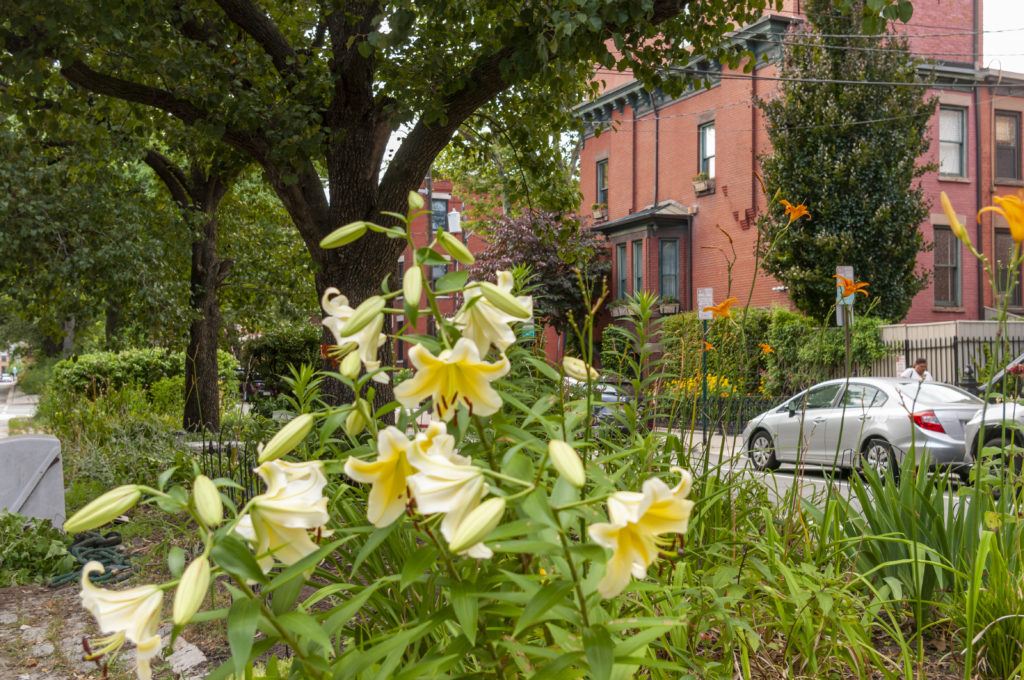
11th Street Lilies: That’s a kind of photograph that exemplifies an urban pastoral sensibility. Loosely speaking it depicts an urban setting, but one that evokes a pastoral mood. In this case the photograph is dominated by the lilies in the foreground, which are in a flowerbed in a median strip running for several blocks on 11th street in Hoboken, New Jersey, where I currently live. It is a residential area, with two and three-story row houses and one or three small low-rise apartment buildings. While the flower bed is obvious enough when you walk the street, it dominates this photograph because I chose to make it so.
* * * * *
It was in graduate school, I believe, that I heard someone refer to Hart Crane as a poet of the “urban pastoral,” referring, I believe to his collection “The Bridge” – which I’ve not read. That was the first time I heard the phrase, “urban pastoral,” and it has stuck in my mind. But the phrase disappeared from view until 2004 when I began wandering my Jersey City neighborhood, camera in hand, in search of wild graffiti.
I photographed the graffiti, of course – lots of it – but that’s not all. I photographed other things as well, close-ups of bees and flowers, panoramas of this or that neighborhood view, of the Manhattan skyline from Jersey City, and – cliche of cliches – sunrises and sunsets. Thus on October, 1, 2007, ago I blogged “This Jersey City My Prison,” in which I set Coleridge’s “This Lime-Tree Bower My Prison” amid photographs taken in Jersey City. I have since reset the poem with photos I’ve taken in Hoboken.
Coleridge wrote the poem while he was confined to the yard in his cottage in Britain’s fabled lake country. He was feeling sorry for himself because he had to miss a nature walk with his friends. Through identifying with his friend “gentle-hearted Charles!” who had “pined/ And hunger’d after nature, many a year,/ In the great City pent” Coleridge had managed to work himself out of a funk. Coming to a close, Coleridge asserts:
Henceforth I shall know
That Nature ne’er deserts the wise and pure;
No plot so narrow, be but Nature there,
No waste so vacant, but may well employ
Each faculty of sense, and keep the heart
Awake to Love and Beauty!
Indeed.
However,I did not post my blog entry from a cottage in the lake country. I posted it from my apartment in Jersey City, a half dozen blocks from the Holland Tunnel, conduit to one of the largest cities in the world, one of a kind Coleridge could not have imagined. These days I’m living a couple of miles from there in a small apartment building in Hoboken, which is along Jersey City’s northern border and is, like Jersey City, across the Hudson River from mid-town Manhattan.
I suppose one could read some kind of irony in the mismatch between my situation and Coleridge’s. But such was not my intention.
I post my photographs at Flickr.com. One can join groups where people post images of some similar kind. Thus I belong to several graffiti groups, a Jersey City group, a Hudson County (where Jersey Gity is located) group, and several others. One of them is called “Urban Nature” and describes its theme thus: “The Urban Nature group is for images of nature in an urban context. It could be a tree on a street corner, a houseplant by a window, or a river through the city.” There’s more to it than that, though not enough to indicate that the group is about the celebration of the urban pastoral, but the suggestion is there in the fact that the group is moderated. Photographs must be approved by an administrator or moderator before they become permanently visible. The group currently has almost 200,000 photographs posted by 60,000 members.
I don’t know what those numbers mean as I do not know what is typical of Flickr groups. I suspect that this is one of the larger groups posting to Flickr. It is certainly in the top 10 percent, by number of members and photographs, of the 144 groups I belong to. I thus take as indicating significant interest in the urban pastoral as a sensibility.
Googling “urban pastoral” produces some interesting hits, though one has to weed through articles and sites having to do with the clergy, e.g. “Seminary Consortium for Urban Pastoral Education.” Back in 2007 I found an essay by one “Donald M. Hassler” on “The Urban Pastoral and Labored Ease of Samuel R. Delany” in a collection of essays, The City in African-American Literature, edited by Yoshinobu Hakutani and Robert Butler. I also learned that one Dr. Matthew Gandy, of University College London, is running a series of workshops entitled, “From the technological sublime to the urban pastoral: rethinking urban and industrial landscapes:”
The “sublime” and the “pastoral” are two of the most enduring ideas in the history and interpretation of landscape but how do these concepts relate to contemporary urban and industrial landscapes? The idea of the “sublime” has in recent years become a vibrant focus for interdisciplinary debate bringing together insights from architectural theory, art history, film studies, cultural geography and other fields of inquiry. Of particular interest is the use of this term in relation to urban and industrial landscapes where an emphasis on the “technological sublime” has emerged as part of a wider attempt to expand our understanding of landscapes that appear to fall outside of or some case contradict established genres of landscape interpretation. The emerging idea of the “urban pastoral” presents an equally rich set of conceptual themes for consideration and has recently been the focus of a range of critical writings on art, landscape and cultural change.
That seems about right, though I can’t say as I’ve been following any of the discussions he alludes to. Rather, I’ve just been following my camera and find myself in the thick of it.
The top hit at that time, however, was to the Amazon entry for Wickerby: An Urban Pastoral, by Charles Siebert. Verlyn Klinkenborg reviewed the book for The New York Times when it came out in 1999 (which also published the first chapter):
To reconnect humans with nature is one thing, but Siebert’s enterprise is to reconnect the city with nature. He does this partly through analogy, of course. A man who lives without permission in a tumbledown cabin is not, perhaps, that different from “the man in the house of refuse” who lives on the sidewalk in front of Siebert’s Crown Heights apartment building. But Siebert reconnects Wickerby and Brooklyn by taking the long view, the all-encompassing perspective that belonged to his father, the tool-and-die man, a maker of the tools that make other tools and a student of fabrication. Everything Siebert sees, plastic bags caught in trees, cassette tape lying unraveled in the grass, is, after his father’s lesson, “earth taken up and pressed against our variously shaped dies to form the parts that suit our briefly passing purposes.”
Siebert’s gospel is a synoptic one. It joins man and nature, machine and flesh, city and country in a single vision, which is rooted in an instinctive human ambition.
That seems to me a noble vision, a necessary one, to join “man and nature, machine and flesh, city and country,” though I’m not sure whether that can adequately be done through “instinctive human ambition,” nor for that matter do I know whether Klinkenborg’s reading is adequate to the book, which I have not yet read.
But that’s a quibble. I write this piece only to raise the issue of the urban pastoral, not to present a definitive view of it. It is something I’m thinking about, working with, exploring, mostly through photography rather than critical commentary.
Let me offer one more perspective, from an article by Terence Diggory, Allen Ginsberg’s Urban Pastoral. In his second paragraph, Diggory notes (p. 103):
In 1977, the poet Kenneth Koch asks Ginsberg, “What would you consider an ideal existence for yourself as a poet?” Ginsberg replies: “Retiring from the world, living in a mountain hut, practicing certain special meditation exercises half the day, and composing epics as the sun sets” (Ginsberg 1977, 9).
Later Diggory notes that we must understand pastoral as a mode, a sensibility, rather than as a bucolic setting for shepherds which are, at best, only conventional genre markers. I note that you won’t find any shepherds in my photographs, and I doubt you’ll find many in Ginsberg either.
He may have longed for a mountain hut, but he lived in cities, New York, San Francisco, Paris, Calcutta, London, and others. And so (p. 113-114):
Having thus “pastoralized” certain aspects of industrial production, Ginsberg occupies a middle position from which he satirizes traditional pas toral ideals as well as industrial pollution. It is typical of urban pastoral to reject the traditional ideal of “the return to nature” as a refuge from city problems: “the country will bring us / no peace,” says Williams (1988, 88 89]; “the country is no good for us,” echoes O’Hara (1995, 476). […] individual mortality and universal entropy. The dream of a “safer, healthier” place is exposed as an illusion: “The Farm’s a lie!” (1984, 547). At the conclusion of “Ecologue,” farmer Ginsberg stares in mock-horror – that is, with the mockery turned on himself – at “bottles & cans piled upin our garbage pail” (1984, 522), just as in “garbage-filled Rome.”
And so, in a way, we return to Coleridge’s lines, “That Nature ne’er deserts the wise and pure; / No plot so narrow, be but Nature there.” On the other hand, one might also consider the possibility that the idea of nature makes no sense unless it can stand in opposition to something, and that something as often as not is the city. If so then the idea of an urban pastoral is simply unlocking a potential inherent in the opposition between city and nature.
* * * * *
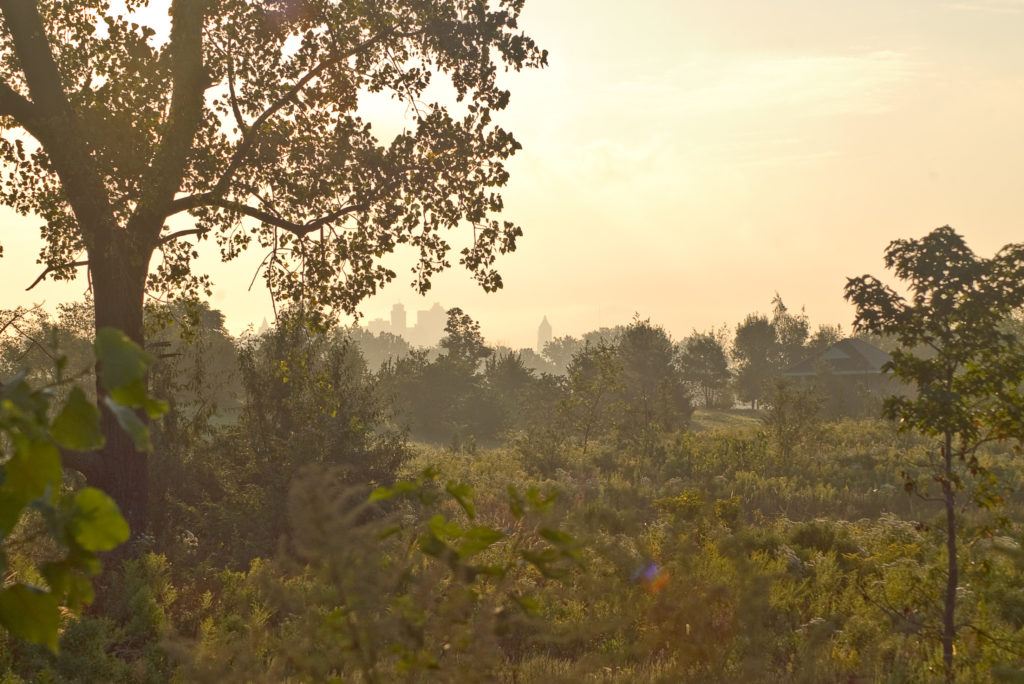
Liberty State Park sunrise: The city is all but obliterated in this photo taken in Jersey City’s Liberty State Park at sunrise. Still, if you look at the top of the tree line in the center you can see the skyline of Jersey City to the left and a bit of Manhattan (the Empire State Building) to the right. Looking carefully to the right you will glimpse the manicured lawn of a well-maintained park and a park building of some kind, perhaps a maintenance shed.
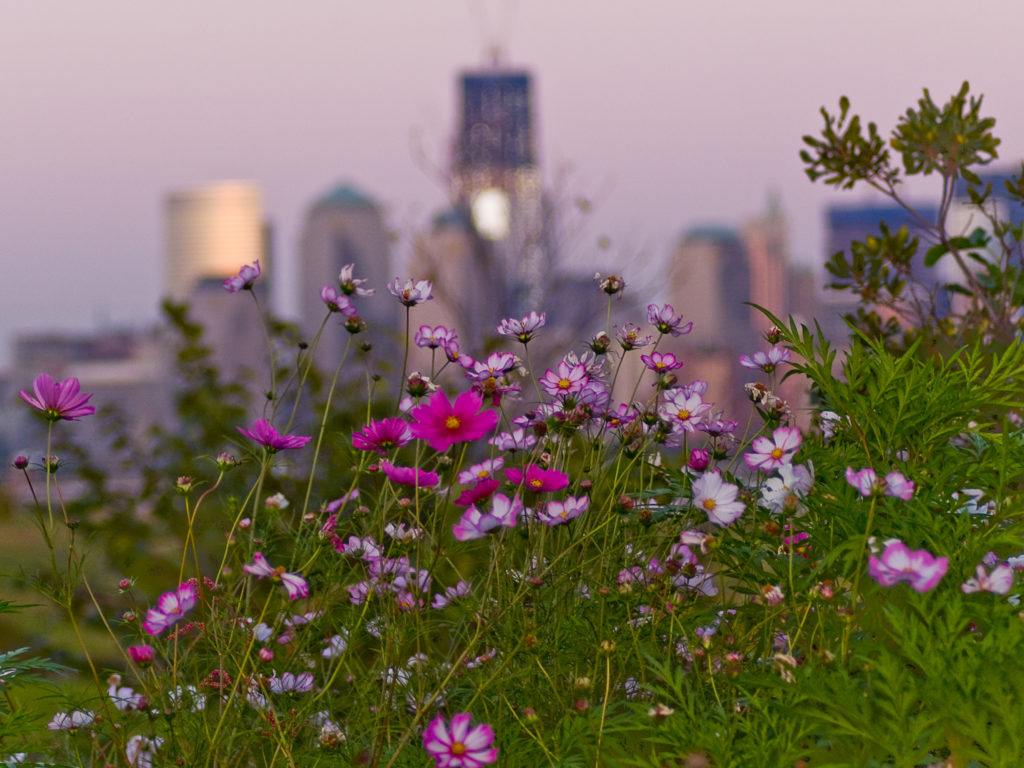
Flowers o’re the city: We are still in Liberty State Park, near the top of a hill at sundown. The foreground is dominated by flowers while we see skyscrapers at the southern tip of Manhattan in the background. The building in the center is One World Center, still under construction.
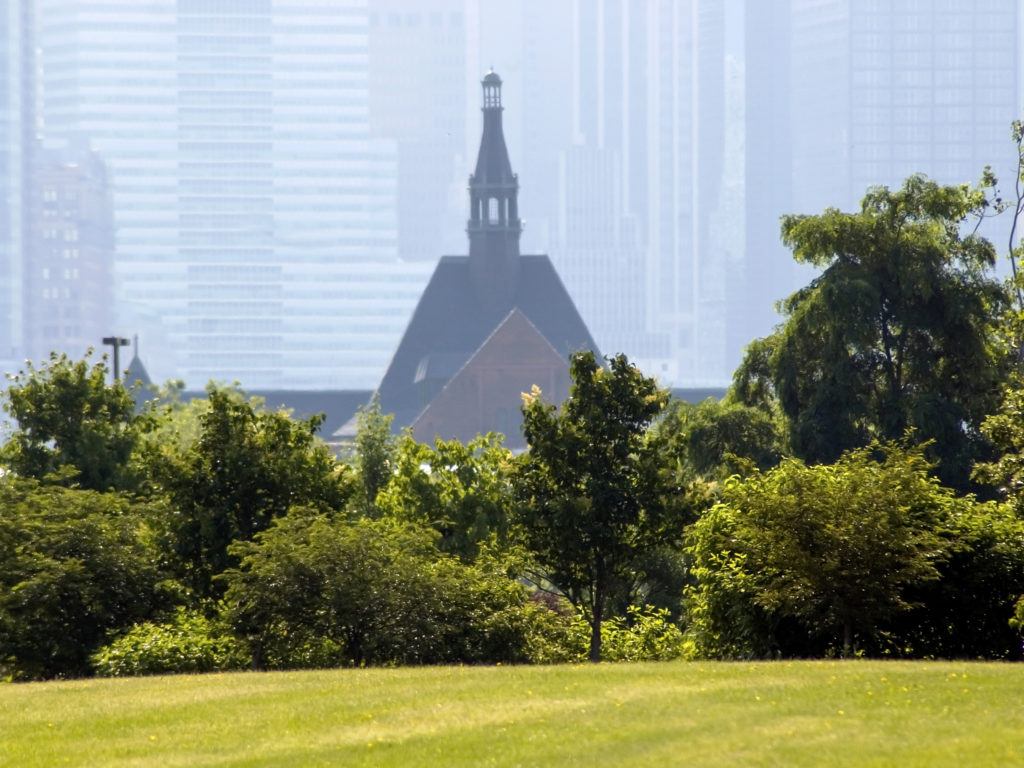
Curtain wall sky: We are still in Liberty State Park. The building in the center is an old train station. A wall of high-rise buildings in Manhattan does service as the sky.
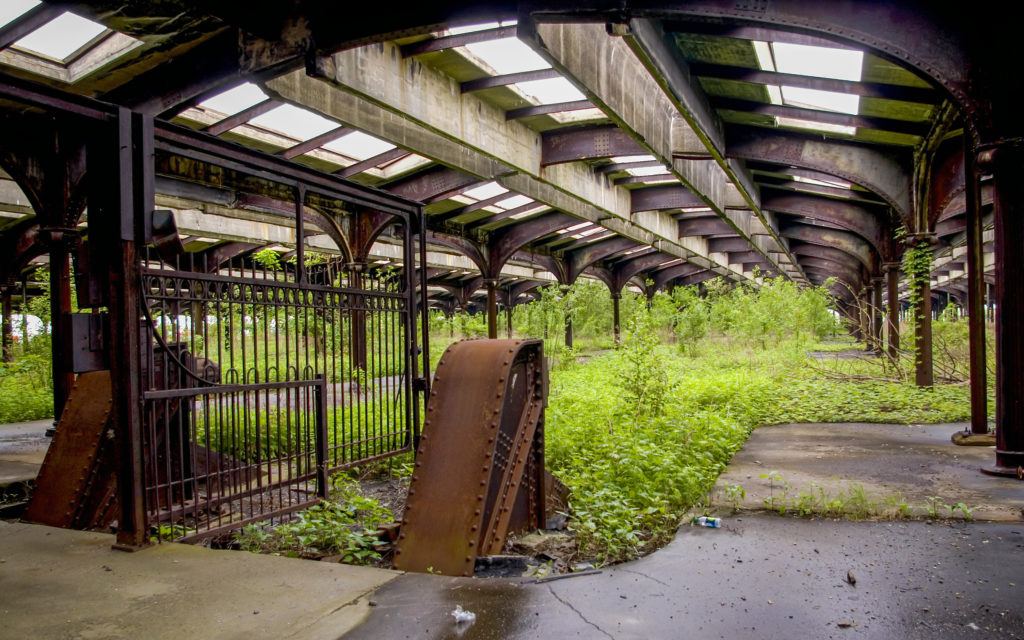
Temple of Transportation: We’re inside the train shed that is adjacent to the station in the previous photo. This is where passengers would board trains going west, or exit trains coming from the west. The greenery was washed out when Hurricane Sandy came through.
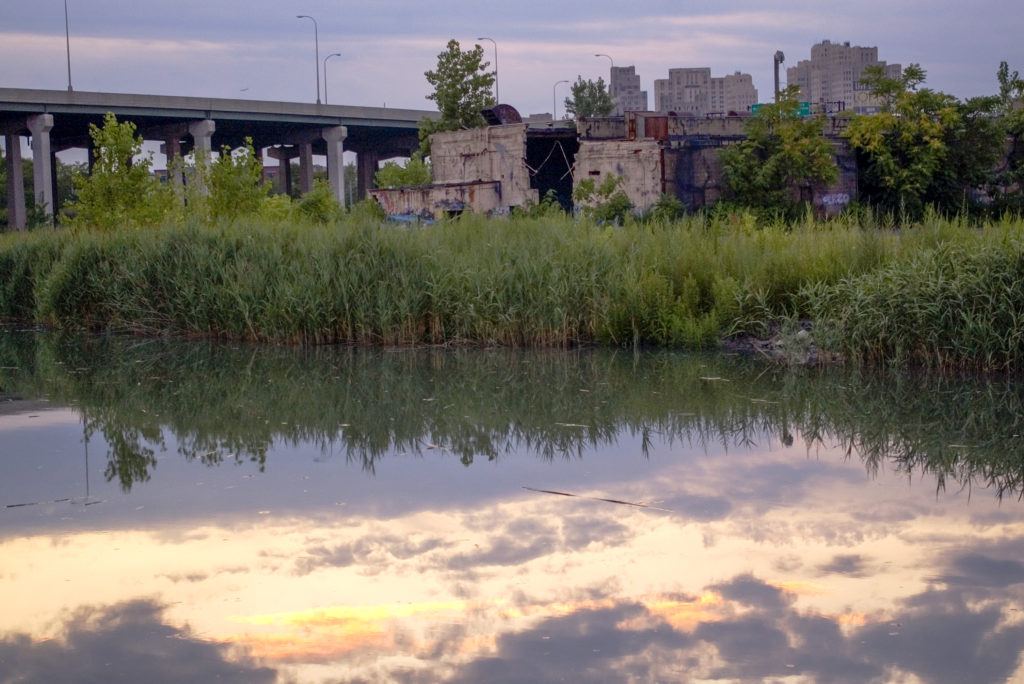
Urban Design Studio at dusk: We’ve left Liberty State Park, which is behind us. That’s the remains of the Morris Canal in the foreground, which transported coal from eastern Pennsylvania. I don’t know what those ruins in the middle were, but I called them the “Urban Design Center” as they were covered with graffiti inside and out. They’ve since been destroyed and new buildings erected on the spot. The buildings in the background at the right are now luxury apartments. They once housed the Jersey City Medical Center.

Hoboken residential street: A typical residential street in the north end of Hoboken. This is within a block or three of the first photo, the one with the 11th Street lilies.

Through the wardrobe door: This little bit of greenery is known to some Jersey City locals as Narnia. It is magical. The first time I went back there I become a ten-year-old play-acting the role of Indiana Jones discovering a lost civilization, which you can see at the right. That’s graffiti on a stanchion supporting the thruway.
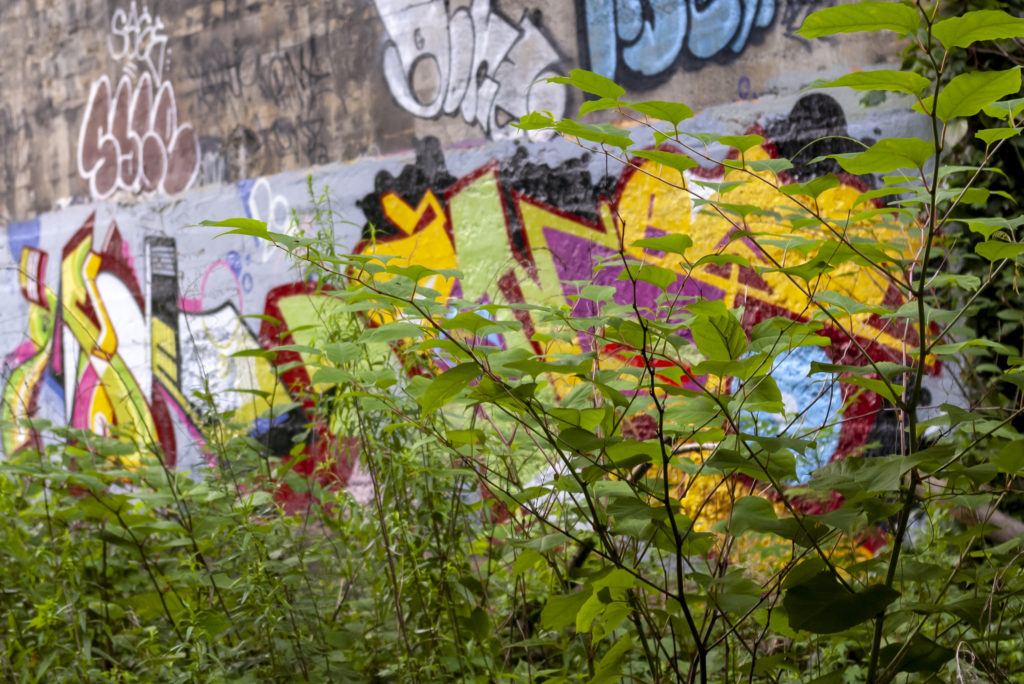
Sonet: We’re getting closer to the heart of that lost civilization. That graffiti – now under a half-dozen more layers – is on masonry supporting the Baldwin Avenue bridge across the Bergen Arches, which is a mile-long trench through the middle of Jersey City. It’s by a writer who goes by the name, Sonet.
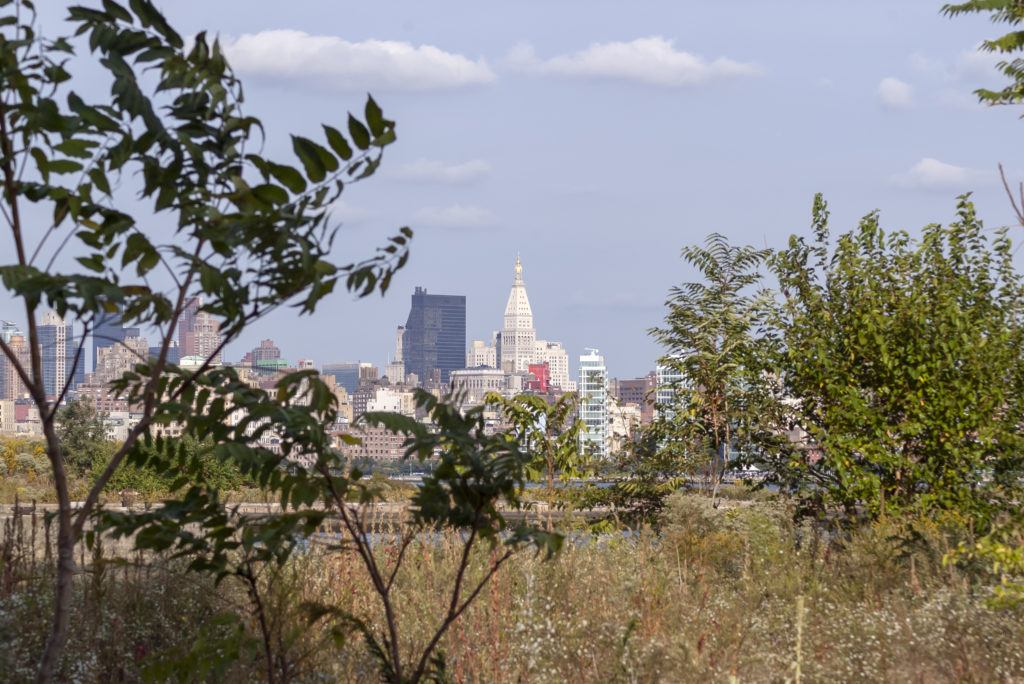
Met Life Tower from afar: Some non-descript field on the northern edge of Jersey City. The small skyscraper in the center, the one with the cupola at the top, is the Met Life Tower in Lower Manhattan, not far from City Hall.

Not a rocket to Mars: The Empire State Building is framed by trees on a pier in Jersey City. That is not how we usually see the building, is it?
* * * * *
Note: This is a revised version of an essay I’d originally published on November 19, 2007 in The Valve under the title, “The Urban Pastoral.”
